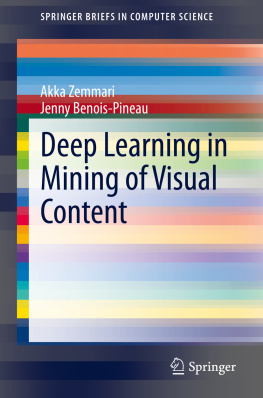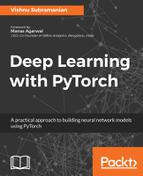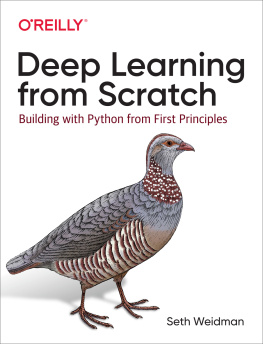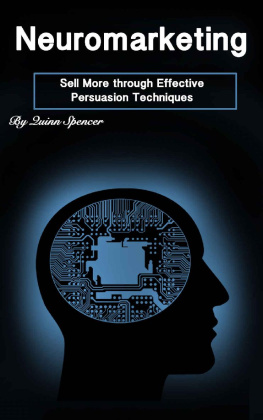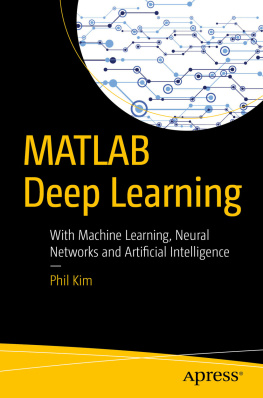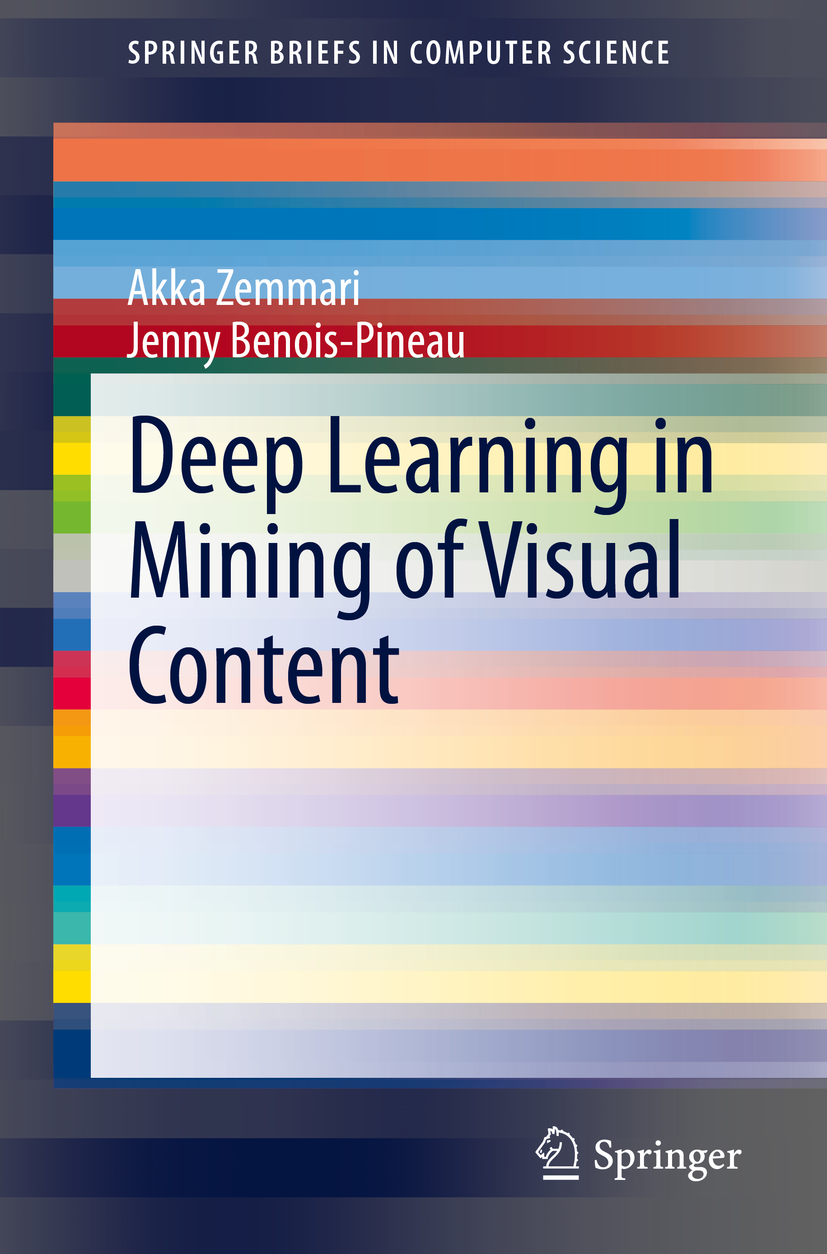SpringerBriefs in Computer Science
Series Editors
Stan Zdonik
Brown University, Providence, RI, USA
Shashi Shekhar
University of Minnesota, Minneapolis, MN, USA
Xindong Wu
University of Vermont, Burlington, VT, USA
Lakhmi C. Jain
University of South Australia, Adelaide, SA, Australia
David Padua
University of Illinois Urbana-Champaign, Urbana, IL, USA
Xuemin Sherman Shen
University of Waterloo, Waterloo, ON, Canada
Borko Furht
Florida Atlantic University, Boca Raton, FL, USA
V. S. Subrahmanian
Department of Computer Science, University of Maryland, College Park, MD, USA
Martial Hebert
Carnegie Mellon University, Pittsburgh, PA, USA
Katsushi Ikeuchi
Meguro-ku, University of Tokyo, Tokyo, Japan
Bruno Siciliano
Dipartimento di Ingegneria Elettrica e delle Tecnologie dellInformazione, Universit di Napoli Federico II, Napoli, Italy
Sushil Jajodia
George Mason University, Fairfax, VA, USA
Newton Lee
Institute for Education, Research and Scholarships, Los Angeles, CA, USA
SpringerBriefs present concise summaries of cutting-edge research and practical applications across a wide spectrum of fields. Featuring compact volumes of 50 to 125 pages, the series covers a range of content from professional to academic.
Typical topics might include:
A timely report of state-of-the art analytical techniques
A bridge between new research results, as published in journal articles, and a contextual literature review
A snapshot of a hot or emerging topic
An in-depth case study or clinical example
A presentation of core concepts that students must understand in order to make independent contributions
Briefs allow authors to present their ideas and readers to absorb them with minimal time investment. Briefs will be published as part of Springers eBook collection, with millions of users worldwide. In addition, Briefs will be available for individual print and electronic purchase. Briefs are characterized by fast, global electronic dissemination, standard publishing contracts, easy-to-use manuscript preparation and formatting guidelines, and expedited production schedules. We aim for publication 812 weeks after acceptance. Both solicited and unsolicited manuscripts are considered for publication in this series.
More information about this series at http://www.springer.com/series/10028
Akka Zemmari and Jenny Benois-Pineau
Deep Learning in Mining of Visual Content
Akka Zemmari
Laboratoire Bordelais de Recherche en Informatique (LaBRI), University of Bordeaux, Talence Cedex, France
Jenny Benois-Pineau
Laboratoire Bordelais de Recherche en Informatique (LaBRI), University of Bordeaux, Talence Cedex, France
ISSN 2191-5768 e-ISSN 2191-5776
SpringerBriefs in Computer Science
ISBN 978-3-030-34375-0 e-ISBN 978-3-030-34376-7
https://doi.org/10.1007/978-3-030-34376-7
The Author(s), under exclusive license to Springer Nature Switzerland AG 2020
This work is subject to copyright. All rights are reserved by the Publisher, whether the whole or part of the material is concerned, specifically the rights of translation, reprinting, reuse of illustrations, recitation, broadcasting, reproduction on microfilms or in any other physical way, and transmission or information storage and retrieval, electronic adaptation, computer software, or by similar or dissimilar methodology now known or hereafter developed.
The use of general descriptive names, registered names, trademarks, service marks, etc. in this publication does not imply, even in the absence of a specific statement, that such names are exempt from the relevant protective laws and regulations and therefore free for general use.
The publisher, the authors and the editors are safe to assume that the advice and information in this book are believed to be true and accurate at the date of publication. Neither the publisher nor the authors or the editors give a warranty, expressed or implied, with respect to the material contained herein or for any errors or omissions that may have been made. The publisher remains neutral with regard to jurisdictional claims in published maps and institutional affiliations.
This Springer imprint is published by the registered company Springer Nature Switzerland AG.
The registered company address is: Gewerbestrasse 11, 6330 Cham, Switzerland
Having written this book for young researchers and professionals, we dedicate it to those who encouraged us, as young researchers, to
Dominique BARBA and Yves METIVIER
Preface
Deep learning is a new trend in artificial intelligence pushing the performances of machine learning algorithms to their real-life applicability for solving a variety of problems the humanity faces nowadays.
Computer vision and multimedia indexing research have realized a general move from all previous approaches to those on the basis of deep learning.
This approach is built on the principles of supervised machine learning and in particular, artificial neural networks. Applied to visual information mining, it also incorporates our fundamental knowledge in image processing and analysis. Today, we translate all our know-how in visual information mining into this language.
The proliferation of software frameworks allows for easy design and implementation of deep architectures, for the choice and adequate parameterization of different optimization algorithms for training parameters of deep neural networks. The availability of graphical processing units (GPU) and of distributed computing made the computational times for learning quite reasonable. For young researchers and those who move to this kind of methods it is important, we think, to get very quickly into comprehension of underlying mathematical models and formalism, but also to make a bridge between the methods previously used for understanding of images and videos and these winning tools.
It is difficult today to write a book about deep learning, so numerous are different tutorials easily accessible on the Internet. What is the particularity of our book compared to them? We tried to keep a sufficient balance between the usage of mathematical formalism, graphical illustrations, and real-world examples. The book should be easy to understand for young researchers and professionals with engineering and computer science background. Deep learning without pain, this is our goal.
Acknowledgements
We thank our PhD students, Abraham Montoya Obeso and Karim Aderghal, for their kind help in preparation of illustrative material for this book.
Akka Zemmari
Jenny Benois-Pineau
Bordeaux, France Talence, France
August 2019
Acronyms
ANN
Artificial Neural Network
CNN
Convolutional Neural Network
HMM
Hidden Markov Model
LSTM
Long Short-Term Memory Network
MLP
Multi-Layered Perceptron
RNN
Recurrent Neural Network
Contents
List of Figures
The Author(s), under exclusive license to Springer Nature Switzerland AG 2020
A. Zemmari, J. Benois-Pineau Deep Learning in Mining of Visual Content SpringerBriefs in Computer Science https://doi.org/10.1007/978-3-030-34376-7_1

